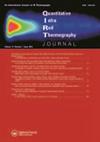Introduction of the combination of thermal fundamentals and Deep Learning for the automatic thermographic inspection of thermal bridges and water-related problems in infrastructures
IF 4.9
3区 工程技术
Q1 INSTRUMENTS & INSTRUMENTATION
引用次数: 13
Abstract
ABSTRACT Infrastructure inspection is fundamental to keep its service performance at the highest level. For that, special attention should be paid to the most severe defects in order to be able to subsequently mitigate or even eliminate them. Therefore, this paper introduces the combination of an automatic thermogram pre-processing algorithm and a Deep Learning (DL) model, Mask R-CNN, applied to thermal images acquired from different infrastructures (buildings, heritage sites and civil infrastructures) with water-related problems and thermal bridges. The pre-processing algorithm developed is based on thermal fundamentals. As an output, the thermal contrast between defect and defect-free areas is increased in each image. Then, Mask R-CNN is trained using the pre-processing algorithm outputs as input dataset to automatically detect, segment and classify each defect area. The training process of Mask R-CNN is improved by the prior application of the proposed pre-processing algorithm in terms of time. This shows the capacity of thermal fundamentals to improve the performance of the DL models for their application to the InfraRed Thermography (IRT) field. In addition, DL models are introduced for the first time in the thermographic inspection of water-related problems and thermal bridges when inspecting an infrastructure.将热学基础知识与深度学习相结合,用于热桥和基础设施中与水相关的问题的自动热成像检测
本文章由计算机程序翻译,如有差异,请以英文原文为准。
求助全文
约1分钟内获得全文
求助全文
来源期刊

Quantitative Infrared Thermography Journal
Physics and Astronomy-Instrumentation
CiteScore
6.80
自引率
12.00%
发文量
17
审稿时长
>12 weeks
期刊介绍:
The Quantitative InfraRed Thermography Journal (QIRT) provides a forum for industry and academia to discuss the latest developments of instrumentation, theoretical and experimental practices, data reduction, and image processing related to infrared thermography.
 求助内容:
求助内容: 应助结果提醒方式:
应助结果提醒方式:


